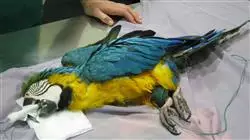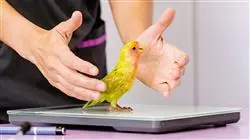University certificate
The world's largest faculty of veterinary medicine”
Introduction to the Program
An intensive and complete study of the different ophthalmologic pathologies affecting exotic animals that veterinarians may encounter in their practice"

During this Postgraduate diploma, the physiology of vision is analyzed by developing the factors involved in the visual process, taking into account the differences that exist in the animal world. Another aspect that is dealt with is ocular pharmacology, a wide field that contains many adversities, due to the anatomical specialties of the eyeball
In terms of treatment, the pharmacokinetics of the drugs and the choice of route of administration according to the desired site of action will be studied
Another fundamental aspect of this Postgraduate diploma is the study of ophthalmologic examination and complementary tests, as well as specialized knowledge of the different diagnostic methods and their indications, coupled with the basic and essential instruments required for a complete ophthalmologic examination
The complete ophthalmologic examination will be discussed, starting with the anamnesis, the clinical history of the patient and the different procedures that can be used to reach a correct diagnosis. The most important procedures, tests and devices that facilitate an accurate diagnosis will be examined
In the final part of the Postgraduate diploma, the anatomy of each species and the main alterations affecting each one of them will be covered, with specific study of the therapeutic methods of exotic species, all of which will lead to improved patient management and optimized results
You will learn the specific and advanced diagnostic protocols in Ophthalmology in Exotic Animals to be able to apply the most appropriate medical or surgical treatment in each case"
This Postgraduate diploma in Ophthalmology in Exotic Animals contains the most complete and up-to-date scientific program on the market. Its most important features include:
- Case studies presented and developed by experts in Veterinary Ophthalmology
- Graphic, schematic, and practical contents created to provide scientific and practical information on the disciplines that are essential for professional practice
- Practical exercises where self-assessment can be used to improve learning
- Its special emphasis on innovative methodologies
- Theoretical lessons, questions to the expert, debate forums on controversial topics, and individual reflection assignments
- Content that is accessible from any fixed or portable device with an Internet connection
Designed to be a practical specialization process, this Postgraduate diploma includes the study of real cases that will allow you to acquire a highly efficient contextual education"
The program’s teaching staff includes professionals from the sector who contribute their work experience to this training program, as well as renowned specialists from leading societies and prestigious universities
The multimedia content, developed with the latest educational technology, will provide the professional with situated and contextual learning, i.e., a simulated environment that will provide immersion programmed to learn in real situations
This program is designed around Problem-Based Learning, whereby the professional must try to solve the different professional practice situations that arise throughout the program. For this purpose, the student will be assisted by an innovative interactive video system created by renowned and experienced experts
Acquire the ability to perform a complete differential approach to ocular pathologies in exotic animals"

All the knowledge in ocular anatomy from an innovative, clear and highly effective perspective"
Why study at TECH?
TECH is the world’s largest online university. With an impressive catalog of more than 14,000 university programs available in 11 languages, it is positioned as a leader in employability, with a 99% job placement rate. In addition, it relies on an enormous faculty of more than 6,000 professors of the highest international renown.

Study at the world's largest online university and guarantee your professional success. The future starts at TECH”
The world’s best online university according to FORBES
The prestigious Forbes magazine, specialized in business and finance, has highlighted TECH as “the world's best online university” This is what they have recently stated in an article in their digital edition in which they echo the success story of this institution, “thanks to the academic offer it provides, the selection of its teaching staff, and an innovative learning method aimed at educating the professionals of the future”
A revolutionary study method, a cutting-edge faculty and a practical focus: the key to TECH's success.
The most complete study plans on the university scene
TECH offers the most complete study plans on the university scene, with syllabuses that cover fundamental concepts and, at the same time, the main scientific advances in their specific scientific areas. In addition, these programs are continuously being updated to guarantee students the academic vanguard and the most in-demand professional skills. In this way, the university's qualifications provide its graduates with a significant advantage to propel their careers to success.
TECH offers the most comprehensive and intensive study plans on the current university scene.
A world-class teaching staff
TECH's teaching staff is made up of more than 6,000 professors with the highest international recognition. Professors, researchers and top executives of multinational companies, including Isaiah Covington, performance coach of the Boston Celtics; Magda Romanska, principal investigator at Harvard MetaLAB; Ignacio Wistumba, chairman of the department of translational molecular pathology at MD Anderson Cancer Center; and D.W. Pine, creative director of TIME magazine, among others.
Internationally renowned experts, specialized in different branches of Health, Technology, Communication and Business, form part of the TECH faculty.
A unique learning method
TECH is the first university to use Relearning in all its programs. It is the best online learning methodology, accredited with international teaching quality certifications, provided by prestigious educational agencies. In addition, this disruptive educational model is complemented with the “Case Method”, thereby setting up a unique online teaching strategy. Innovative teaching resources are also implemented, including detailed videos, infographics and interactive summaries.
TECH combines Relearning and the Case Method in all its university programs to guarantee excellent theoretical and practical learning, studying whenever and wherever you want.
The world's largest online university
TECH is the world’s largest online university. We are the largest educational institution, with the best and widest online educational catalog, one hundred percent online and covering the vast majority of areas of knowledge. We offer a large selection of our own degrees and accredited online undergraduate and postgraduate degrees. In total, more than 14,000 university degrees, in eleven different languages, make us the largest educational largest in the world.
TECH has the world's most extensive catalog of academic and official programs, available in more than 11 languages.
Google Premier Partner
The American technology giant has awarded TECH the Google Google Premier Partner badge. This award, which is only available to 3% of the world's companies, highlights the efficient, flexible and tailored experience that this university provides to students. The recognition as a Google Premier Partner not only accredits the maximum rigor, performance and investment in TECH's digital infrastructures, but also places this university as one of the world's leading technology companies.
Google has positioned TECH in the top 3% of the world's most important technology companies by awarding it its Google Premier Partner badge.
The official online university of the NBA
TECH is the official online university of the NBA. Thanks to our agreement with the biggest league in basketball, we offer our students exclusive university programs, as well as a wide variety of educational resources focused on the business of the league and other areas of the sports industry. Each program is made up of a uniquely designed syllabus and features exceptional guest hosts: professionals with a distinguished sports background who will offer their expertise on the most relevant topics.
TECH has been selected by the NBA, the world's top basketball league, as its official online university.
The top-rated university by its students
Students have positioned TECH as the world's top-rated university on the main review websites, with a highest rating of 4.9 out of 5, obtained from more than 1,000 reviews. These results consolidate TECH as the benchmark university institution at an international level, reflecting the excellence and positive impact of its educational model.” reflecting the excellence and positive impact of its educational model.”
TECH is the world’s top-rated university by its students.
Leaders in employability
TECH has managed to become the leading university in employability. 99% of its students obtain jobs in the academic field they have studied, within one year of completing any of the university's programs. A similar number achieve immediate career enhancement. All this thanks to a study methodology that bases its effectiveness on the acquisition of practical skills, which are absolutely necessary for professional development.
99% of TECH graduates find a job within a year of completing their studies.
Postgraduate Diploma in Exotic Animal Ophthalmology
Immerse yourself in the fascinating field of exotic animal ophthalmology with our Postgraduate Diploma program at TECH Global University. Discover the tools necessary to provide specialized, quality care to these unique species and take advantage of the benefits of our online classes to develop your skills from anywhere. At TECH Global University, we understand the importance of ophthalmology in exotic animals to ensure their welfare and visual health. Our Postgraduate Diploma program gives you the opportunity to acquire updated and specialized knowledge in this constantly evolving area. Online classes are the perfect option for veterinary professionals who wish to expand their knowledge in exotic animal ophthalmology. With our online learning platform, you can access the contents of the program in a flexible way and adapt your studies to your professional and personal responsibilities.
Your passion for veterinary medicine in the service of vision
TECH Global University is proud to have an expert and committed faculty that will guide you throughout this Postgraduate Diploma program. Through the lessons, you will delve into topics such as diagnosis and treatment of eye diseases in exotic animals, interpretation of diagnostic tests, surgical management and prevention techniques for ophthalmologic conditions. The demand for professionals trained in exotic animal ophthalmology continues to grow as more people adopt and care for these wonderful creatures. With our Postgraduate Diploma, you will be prepared to excel in this specialized field and provide quality care to your patients. Don't miss the opportunity to realize your passion for veterinary medicine and exotic animal ophthalmology. Enroll in the Postgraduate Diploma program at TECH Global University and become a reference in the visual care of these fascinating species.







